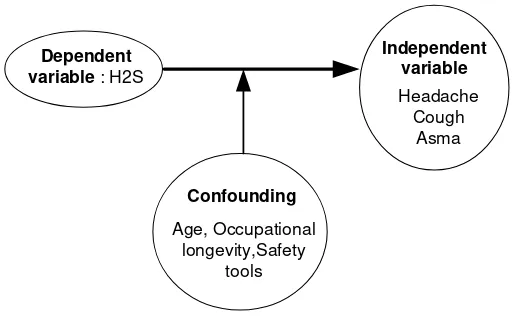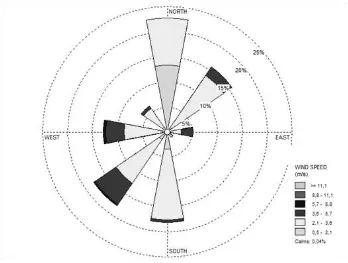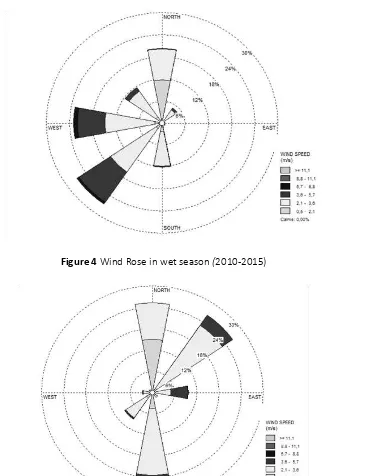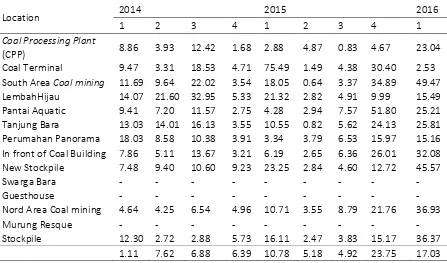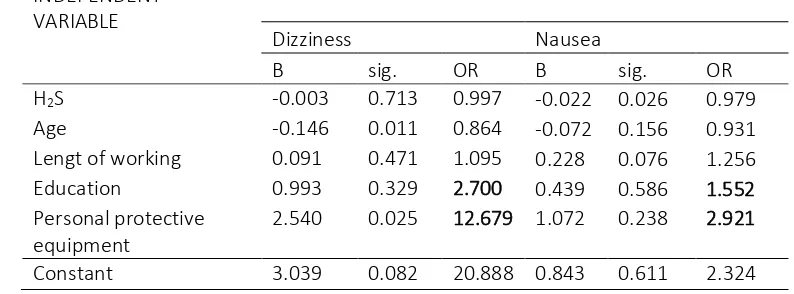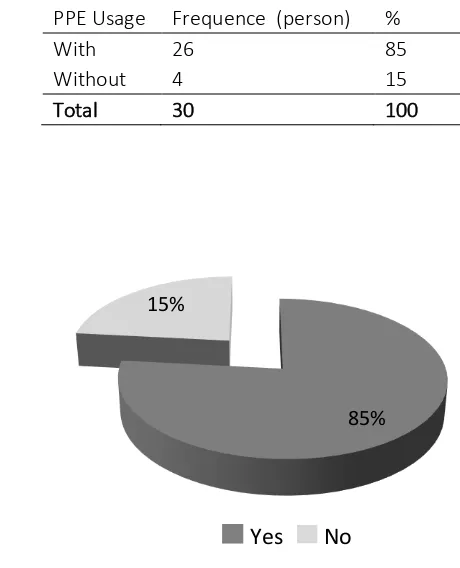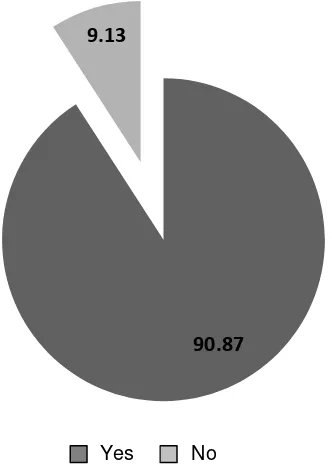H
2S EXPOSURE TO WORKERS IN COAL INDUSTRIES (CASE STUDY IN
SURALAYA COAL YARD AND EAST KALIMANTAN COAL MINING)
Margareta Maria Sintorini
Environmental Engineering, Faculty Landscape Architecture and Environmental Technology, Universitas Trisakti, Jakarta, 11440, Indonesia
*Corresponding author: [email protected]
ABSTRACT
Aims: This study is aimed to identify the hazards and occupational risk factors of Hydrogen sulfide as one of the most dangerous gas exposures for employees coming from coal, oil and gas companies. Hydrogen sulfide is a toxic colourless gas with a characteristic odor, soluble in various liquids including water. This gas is irritant and asphyrant that can be absorbed through lung into blood. Its inhalation exerts hard damage of respiratory tract. Methodology and Result: The method used is the analysis of questionnaires with logistic regression statistics. The numbers of respondents are 170 people from the employment population who work in coal mining and Pertamina production units. Results obtained from workers' observations and H2S sampling suggest that the most dominant source of H2S exposure hazard comes from the
skim tank and DAF areas. The variables associated with shortness of breath was age (P = 0.006). As many as 17.3% of workers did not apply proper work procedures, and 30.58% of workers had experienced work accidents. Conclusion, significance and impact study: H2S are not
related to complaints of dizziness or shortness of breath of workers. Specific factors related to occupational safety are long-term exposure of work factors related to complaints of shortness of breath (OR = 2,061), and factors not using PPE associated with dizziness (OR = 3,484)
MANUSCRIPT HISTORY
Hydrogen sulfide is a colorless gas with a characteristic odor, soluble in various liquids including
(H2S) is present in the atmosphere at a concentration of 1/100 million or less, H2S will cause
odor disturbance at 0.1 ppm.
Hydrogen sulphide arises and involves in the natural cycle of sulphur. It occurs in volcanic
gases and can be produced by bacterial action trough the direct reduction of sulfate during the
decay of plant or animal protein. It can also be produced by bacteria through direct reduction of
sulfate. Significant concentrations of hydrogen sulphide occur in coal, crude oil, natural gas
fields and in geothermally active areas, as well as in the Kraft process for producing wood pulp.
The production process of coal, oil and natural gas often causes health problems due to the
high exposure of H2S. High doses of H2S exposure can cause death, whereas intensive exposure
in low to moderate concentrations can cause respiratory, eye, nerve, cardiovascular, metabolic
disorders, and reproductive effects, but the carcinogenic effects in humans caused by hydrogen
sulfide have not been found.
Inhalation of H2S exerts an irritant action throughout the entire respiratory tract affecting
the body system and serious health impact. Data on exposure to hydrogen sulfide comes from
reports of acute poisoning cases, occupational exposure, and limited community studies.
Exposure to hydrogen sulphide in high concentrations can be found in numerous
occupations. Workers in the oil, gas, and petrochemical industries are occasionally exposed to
hydrogen sulphide in concentrations sufficient to cause acute intoxication (Sirmon, 2013).
This study identifies the hazards and occupational risk factors of Hydrogen sulfide as one of
the most dangerous gas exposures for employees coming from coal, oil and gas companies.
Spesific goals of the study are to analyze the environment, H2S level, and potential hazards and
risks in coal mining area of Kaltim Prima Coal and Pertamina Field Tambun Production
Operation. Also to analyze the environmental conditions compared to the standard threshold
values.
2.
RESEARCH METHODOLOGY
The research was conducted at PT Kaltim Prima Coal's production facility located in Sangatta,
East Kutai and Production Operation owned by PT Pertamina Field Tambun in Bekasi, from April
Dependent
Primary data were obtained from observations and questionnaires on 170 workers.
Logistic regression analysis used to predict probability is logit equation (Bungin, 2004) as
follows:
𝑔 ( 𝑥) = 𝛽 0 + 𝛽1 𝑥1 + 𝛽 2 𝑥2 + 𝛽 3 𝑥3 (1)
The probability of a logit equation is determined by following formula:
π ( x) =
1− eeg(x)g(x) (2) π ( x ) is the probability of occurrence of risk from hazards arising from the production
process
g ( x ) is the estimated value of logit
β0, β1, β2, and β3 are coefficient values for constant variables.
The Odds ratios are determined by the formula:
𝑝1 (1−𝑝1)
𝑝2 (1−𝑝2) (3)
Determination of Hydrogen Sulfide (H2S) using Method Methylene Blue Arabinogalactan is
as explained below :
The sulfide is precipitated as cadmium sulfide to prevent air oxidation of the sulfide which
occurs rapidly in an aqueous alkaline solution. Arabinogalactan is added to the cadmium
hydroxide slurry to minimize photodecomposition of the precipitated cadmium sulfide. The
collected sulfide is subsequently determined by spectroscopic measurement of methylene blue
produced by the reaction of sulfide with a strongly acid solution of the
p-N,N-dimethyl-p-phenylenediamine and ferric chloric.
Measurements with a spectrophotometer were performed at a wavelength of 670 nm,
using reagents:
a. Amine sulfuric acid stock solution
b. Amine test solution
Geophysics Agency, East Kutai Province of East Kalimantan (Figure 2-5). This wind rose is made
using Lakes Environmental WRPLOT (Wind Rose and Wind Class Plots for Meteorological Data)
application See version 7.0.0.
In the wet season Wind Roses (November-April) has the dominant wind direction is
Southwest, West and North with range of 15% -30% (Figure 4). For the dry season
(May-October) Wind Roses has the dominant wind direction is northeast, north and south, with range
Workers around the study site felt uncomfortable and complained about the smell of
H2S.The probability of disease caused by H2S exposure can be evaluated using logistic regression
analysis. Dependent variable of the analysis consists of complaints of dizziness and nausea while
the independent variable consists of exposure H2S, age, years of service, and use of PPE.
Figure 2 Wind Rose (2010-2015)
Figure 4 Wind Rose in wet season (2010-2015)
Figure 5 Wind Rose in dry season (2010-2015)
The measurements of the H2S levels were conducted in Kaltim Prima Coal's coal mining
work area, as well as at DAF, Tank Scheme and Deaerator at Pertamina Field Tambun. Results of
Table 1 H2S Concentration in Kaltim Prima Coal Mining
Table 2 Ambient Concentration of H2S in coal mining area
Area H2S (µg/m3)
1.
Southern area of
coal mining
37.2 µg/m32.
Northern area of
coal mining
30.65 µg/m33.
Coal Storage Building
15.3 µg/m34.
Southnew Stockpile
10.67 µg/m35.
North of old Stockpile
28.75 µg/m3The concentration of H2S in Pertamina was obtained based on measurement of exposure on
workers for 8 hours working in DAF Unit, Skim Tank and Deaerator, see Table 3. Statistical
Table 3 H2S concentration in Pertamina Field Tambun
Table 4 Statistical analysis of complaints dizziness and shortness of breath on exposure factors H2S, age, working period, education and use of PPE
INDEPENDENT
Table 5 Multivariate analysis complaints dizziness and nausea to exposure factors H2S, Age,
period, education and use of PPE
INDEPENDENT
2. PPE usage factors have an odd ratio or risk rating of 3.484 and 12.679. This concludes that
workers who do not use PPE have a probability of 3.5 times while workers at Pertamina site
have a greater risk of 12.7 times than workers who use PPE.
3. It is also known that educational factors play an important role for the occurrence of health
problems. Education in this case can be formal education or training held by companies.
The risk for the uneducated by OR = 2.7 and OR = 1.5 times higher than those with
adequate education.
The complaints of nausea and dizziness experienced by workers have significant relationship
to exposure to H2S, occupational accidents, and occupational diseases. The results of this
statistic can be interpreted as an indication that most workers have been adhering to the
proper implementation of health and safety management, also that the company has provided
enough safety equipment such as Personal Protective Equipment (PPE) to be used.
Factors causing dizziness and nausea to the worker are educational background. People
with higher education have better knowledge than those with lower education (Notoatmodjo,
2003). The ILO revealed that 85% of the major causes of occupational accidents or diseases are
human factors and 15% are caused by dangerous conditions (Ramli, 2010).
Following are the efforts to control H2S exposure:
1.
To prevent the increase of H2S concentration by measuring it every day2.
To use gas masks instead of dust masks3.
Routine checking of workers with PPE as they work4.
To increase knowledge and emergency response through regular training5.
Routine health checks3.2
The Factor of usage PPE
According to OSHA, personal protective equipment (PPE) is defined as a tool used to protect
workers from injuries or illnesses caused by hazards in the workplace, whether chemical,
biological, physical, electrical, mechanical and other (Supriyadi, 2005). Personal Protective
Equipment is a device that serves to protect workers from exposure to external sources of
energy that can lead to an accident. The level of PPE usage by respondents can be seen in
Table 7 PPE usage in Pertamina Tambun
PPE Usage Frequence (person) %
With 26 85
Without 4 15
Total 30 100
Figure 7 PEE usage in Pertamina Tambun
The Figure 7 shows that 85% of respondents always use the complete PPE while working,
15% of respondents do not use complete PEE and do not even use or ignore the rules. Results
of analysis on workers using PPE are as follows
1. 84 % of Workers have always use the complete PPE, while 15.38% of workers did not
always use the complete PPE.
2. Workers comply with OHS that have been fully applied.
3. 96% of respondents have worked according to standard operation procedure (SOP), while
3.8% of respondents work with less attention to SOP as a reference for K3
4. Health service facilities that have been provided contributed benefit of 85% to
respondents, while 15% of respondents did not feel the benefits of health facilities that
have been provided
5. 98% of respondents had paid attention to safety sign while working and 1.9% of
respondents had less attention to safety sign while working 85% 15%
6. 67% of respondents paid attention to the Material Safety Data Sheet (MSDS) of each
chemical used. While 33% of respondents still do not understand MSDS on any chemicals
used.
7. All respondents (100%) always be aware to labels on any hazardous materials used.
8. 96% of respondents always maintain the PPE condition that has been provided by the
company well, while 3.8% of respondents were still less disciplined in maintaining the PPE
performance that has been provided.
Yes No
Figure 8 Application of OSH in Pertamina Tambun
Figure 8 indicates that 9.13% of workers have got accidents in the workplace and
occupational diseases because they carelessly neglect OSH management procedures. While
these kinds of things are not experienced by 90.87% of employees, as they work according to
OSH management guidelines.
4.
CONCLUSION
Symptoms of shortness of breath caused by H2S exposure correlated significantly with variable
of age (p: 0.006). A total of 17.3% of workers do not apply all OHS management procedures
ended up with work accidents and occupational diseases. 30.58% of respondents have 90.87
experienced work accidents due to lack of attention to work procedures, careless, and machine
errors. H2S are not related to complaints of dizziness or shortness of breath of workers. Specific
factors related to occupational safety are long-term exposure of work factors related to
complaints of shortness of breath (OR = 2,061), and factors not using PPE associated with
dizziness (OR = 3,484)
5.
ACKNOWLEDGEMENT
The authors express gratitude to the PT. EP Pertamina Field Tambun and PT. Kaltim Prima Coal,
East Kalimantan, Febrian Dwi Putra and Meitra Rezeki.
6.
REFERENCES
Bungin, B. 2005. Metodologi Penelitian Kuantitatif. Prenada Media Group, Jakarta
Soekidjo, Notoatmodjo. 2003. Metodologi Penelitian Kesehatan, Rineka Cipta, Jakarta
Ramli, Soehatman, Sistem Manajemen Keselamatan dan Kesehatan Kerja OHSAS: 18001, 2010, Dian Rakyat, Jakarta
Supriyadi. 2005. Keselamatan Kerja dan Pencegahan Kecelakaan. Cetakan Keempat, CV. Haji Mas Agung, Jakarta.
